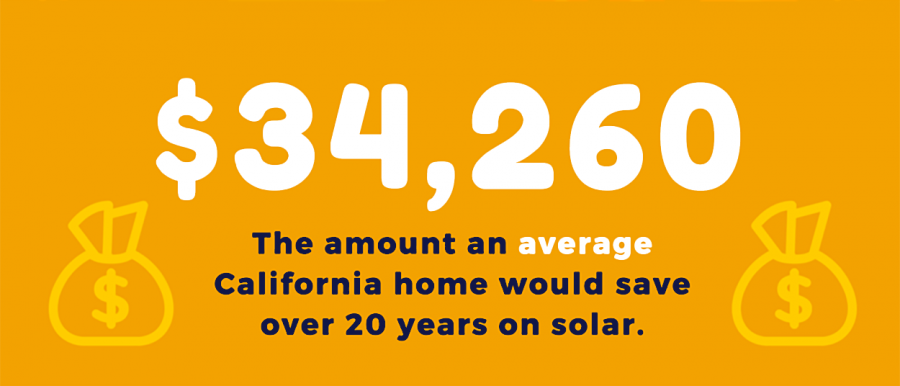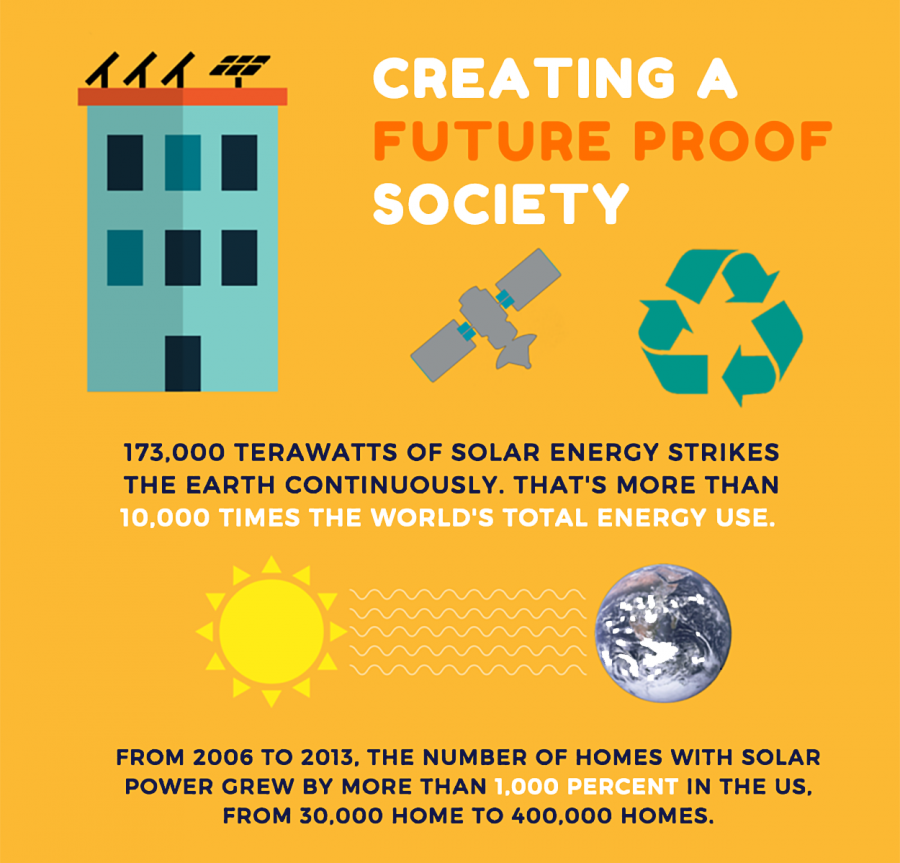Your donation will support the student journalists of Carlsbad High School. Your contribution will allow us to purchase equipment and cover our annual website hosting costs.




March 19, 2016
The Problem:
Schools within San Diego rely on the utilities of San Diego Gas & Electric to power campuses. However, schools throughout San Diego have recently faced a 39% increase in electricity costs, resulting in a year over year increase of $25 to $30 million. In response to the higher prices, some schools have attempted to turn to solar for a cheaper, cleaner source of energy, but they have found no solutions. Even though schools are considered small businesses, they do not receive the same money-saving benefits because they are non-profit organizations.
“As a county we have SDG&E as our provider, and we have seen consistently high increases in the utility costs, primarily electricity over the past decade,” Deputy Superintendent and Administrative Services Suzanne O’Connell said. “What is significant about the increases is that we are lumped into a rate category with small commercial businesses. So what a typical small business would do if rates went up, is pass along the cost to the consumer.”
Although schools believe they should be able to have their own rate category, SDG&E thinks otherwise because when looking at their hours of operation, they appear to be businesses.
“There have been rate increases for all of our customers and that includes our residential customers and all our different business classes,” Senior Communications Manager at SDG&E Amber Albrecht said. “There are a few different customers that make up business customers, and a lot of that is actually driven by state wide mandates making sure that we are purchasing enough renewable energy. SDG&E actually delivers 1/3 of our energy from renewable sources, such as wind and solar. So that’s a key component of the rate increases that have gone beyond schools.”
SDG&E has organized its businesses’ rate structure using six categories: small commercial, agricultural, medium/large commercial, lighting only, system total and residential. All of these are charged differently according to SDG&E’s policies.
“Schools don’t fit in any of these categories, so they have lumped us into small commercial,” O’Connell said. “We asked them to lump us into agriculture because their rates went down, due to the droughts and other issues. We believe that if there is anywhere we belong, it should be in agriculture. More importantly we are asking for a separate rate structure for schools.”
The reasoning for these high prices are due to various events, according to O’Connell. Recent studies concerning San Diego schools’ electricity have shown a range of reasons for the price hikes.
“SDG&E cited that the wildfires made them raise prices because when power lines went down they had to install brand new ones,” O’Connell said. “They also cited when San Onofre shut down, since it was a shut down of a local power source. However, schools feel that none of these reasons ought to be unfairly and disproportionately levied against schools as small commercial businesses, because they are not. They cite a lot of reasons but I don’t think any of them justify the significant increase they have proposed.”

The Effect:
When SDG&E raised the prices, schools were incapable of passing prices on to the consumer, and struggle to adjust to the change in budgeting.
To make up for the higher prices, schools are forced to find alternative ways to pay for the costs. Schools have had to use money from the Local Control Funding Formula (LCFF), which is money given to schools based on both the number of registered students and attendance, and the needs of the students.
“California had a funding mechanism that was in place for 40 years and your funding was either restrictive, within up to 40 different categorical programs, or unrestrictive, which was your general fund budget,” O’Connell said. “When those categorical programs were in place, you could only spend the amount of money for the purposes for which they were allocated. Now, for the most part they’ve all gone away. Free and reduced lunch students, English-learners, foster youth all generate under the LCFF’s additional dollars because they figured, the more needy the student the more expensive it is to educate them. Carlsbad has a very low percentage of that category of students as mentioned, only 20% of our students. Under this new funding formula, schools don’t get a lot of extra, they just get a base amount which is what they operate under. So this increase in utility costs comes right off the top of that funding that’s to go for the education of the students.”
Under the commercial business category, schools have had to use 19% of the LCFF Base Grant for electricity costs. This 19% could have gone to increase and improve services for all students.
“In the case of a school district, costs cannot be passed on to the customer,” O’Connell said. “So what happens is that money comes out of the same pot of money that is in place to educate students: books, teacher salaries, materials and supplies, classrooms, anything that is associated with the educational program.”
To prevent schools from having to spend more money on their energy bills, SDG&E has made reforms to help alleviate the costs.
“We have a pilot program that we just started for school kitchens that will make it so they have a separate electric meter for all the costs of the schools that are incurring energy costs to provide food to students,” Albrecht said. “What that does is allow these schools access to some statewide funds to pay for that portion of their energy bill. There is also Prop. 39, which is a bucket of statewide dollars, an incentive that schools can use to make investments in energy efficiency. SDG&E actively works with schools in what is called a State Ability Collaborative to help them work through ways to use the Prop 39 funds for types of lighting that they are using. The best way to save on your energy bill, at the end of the day, is by using less energy which is what Prop 39 really aims to do.”

The Solution:
Since this is such a large matter, it is going to take more than just the efforts of one school. Forty of the forty-two school districts in San Diego have joined an energy coalition that is working to have the California Utilities Commission recognize districts as their own category.
This topic has become so widespread that it has received attention in legislation, which may help solve the problem. For example, San Diego assemblywoman Shirley Weber has designated her time to try to get SDG&E to create a separate rate structure for schools.
“Right now through the coalition, we are working on three bills and have certain legislators interested in sponsoring these bills,” O’Connell said. “We have gotten the attention of the Sacramento politicians and we are unique in the sense that SDG&E has higher rates and purposing higher rates than any of the other regions in California. All the districts pitched in money to form the coalition, hire an attorney, hire rate experts and have several spokespersons in the county that appear on a regular basis in front of the energy commissions to defend school districts’ positions against SDG&E; so far it has been very successful.”
SDG&E recently proposed a settlement agreement stating they could do a study of the school’s bills of the past 12 months and hold that price firm for the next three years.
“We thought it wasn’t that bad of an idea, but what we would like SDG&E to do is take each of the 42 districts and calculate what their rate would be for three years and show us whether it is a savings or cost,” O’Connell said. “After finding the calculations of 42 districts, there were only about five districts out of 42 that would benefit. We figure that when dealing with SDG&E over a settlement agreement, they will be right back and ready to raise rates at the end of those three years.”
Even though efforts are being made to resolve the problem through legislation, schools still feel as if they have no power.
“Our Carlsbad Unified and other districts are working with SDG&E because some of these price hikes are ridiculous,” principal of Sage Creek Mr. Morales said. “I know that there is an ongoing venture to try to figure out how to mitigate those costs. I mean we have 11,000 students in this district, about 16 different campuses, so there has to be a way to get some cost savings or maybe create incentives for schools to put solar panels up. Imagine being SDG&E, how many more incentives do you want to give people to get solar panels, when that is only going to take away from your business?”
SDG&E is trying their best to try to find a happy medium that will satisfy both the schools and their company as well.
“We have been actively working with the school districts on their concerns with their energy bills and what we can do to help alleviate those concerns,” Albrecht said. “There is a proposal or settlement that is with the schools right now that will bring all of the schools certainty as to their energy bills of the future and whether or not they are going to have to pay to help with future budgeting. This is actively in review right now.”
The school district is now looking for legislative fixes by passing three bills concerning a school only rate class, intervenor compensation and economic options for solar.
“The first thing we are going after is a separate rate structure for schools,” O’Connell said. “The second thing is money for school districts to fight people like SDG&E and the California Energy Commission because if we have to take money out of this bucket that’s for instruction and schools and start paying dollars out of that same bucket to defend this that’s going to have the same impact to that bucket than anything else does and so we are sponsoring legislation that would give money at the state level to schools to fight increases in cost. The third area is specific to solar schools by ensuring that their investments do not become noneconomic.”

Solar:
Some schools thought turning to solar would be more efficient and were under the impression that they would receive cheaper rates, but SDG&E wanted to shift the peak hours to the evening where there is no sunshine. The School Energy Coalition fought against this decision because high schools have many activities after school. For the time being there has been a reprieve on this shift of peak hours.
School districts in San Diego County have entered in long-term solar agreements where they are responsible for either purchasing their own equipment or leasing the equipment over a long period of time; these agreements are minimally 20 years or longer.
“Right now the reason why it is a bad time is because a lot of the school districts, when they first calculated what their savings would be, showed that they would have significant savings by installing solar at their schools,” O’Connell said. “However, if SDG&E decides to change the rates for solar schools then you never know whether it is going to be worth the savings or not. In some instances, the schools that have already installed solar have ended up paying more in a year than they would have under electricity. They started taxing with a tariff that basically says ‘We are going to tax you for not using our product even though you are on our grid,’ which makes it more expensive than electricity. One of the reliefs we are trying to seek through legislature is that they would guarantee school districts who installed solar would some how be grandfathered into whatever conditions existed at the time they installed solar.”
Even though this seems contradictory, SDG&E claims they provide certain rate options based upon hours of usage to all their customers.
“The way time of use rates are set up are with the California Public Utilities Commission, or the CPUC, and they offer the regulatory oversight for SDG&E,” Albrecht said. “So any changes that SDG&E make related to rates, how we bill our customers or how we actually send money will go before this CPUC. This includes the hours for certain customers who sign up for this rate and their rate can change based on the time they are using energy. That is not specific to solar customers, that’s actually an option that we give all of our customers including business customers.”
La Costa Canyon was one of the first San Diego schools to install solar, and inspired other schools to adopt renewable energy. Although after researching, they were not able to find any benefits because of the high prices.
“Our campus has the infrastructure to have solar panels,” Sage Creek Principal Mr. Morales said. “But with the initial build-out, solar panels were not included as part of that package. It’s a high efficiency campus, the only element that wasn’t incorporated were the solar panels. So the infrastructure is there, should we ever go towards that direction, but there are other measures that we’re doing to be cost effective. I did some research on how much it would be, and it would be in the millions. I found this when I was looking up La Costa Canyon several years ago, when they put up the solar panels in their parking lot.”
As the issue continues, schools are waiting for the ideal time to take action in installing solar. They want to support solar energy because of its many environmental benefits, but the inconsistent prices are preventing them from switching over.
“What we are waiting on now as a school district to pursue the possibility of solar is some certainty that if we get in the business of solar our rates won’t fluctuate over time,” O’Connell said. “As a district we either need to work to pass another bond or some funding mechanism to go out and purchase the equipment yourself, if not you can lease. Homeowners have had a much lower rate hike through SDG&E, theirs might be 9 percent while schools were 16 percent. Year over year our electricity costs, particularly in a very hot year such as two summers ago, we saw nearly a double in our bill over a year. You are talking millions of dollars to provide electricity to 14 schools. We are waiting for the right time where installing solar makes sense for schools. All our sister schools that have solar have said do not go down this path until you get some guarantees that the savings that they calculate for you today will be sustained over time.”
Your donation will support the student journalists of Carlsbad High School. Your contribution will allow us to purchase equipment and cover our annual website hosting costs.




Muku • Mar 26, 2016 at 10:00 pm
This is so awesome. We were looking to get solar panels on our home when I came across this. What a great school paper! You kids are doing a great job.